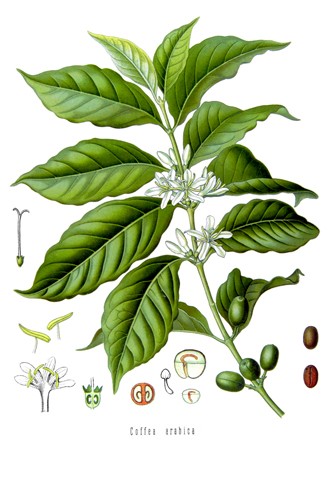Features on Asian Art, Culture, History & Travel
Features
Features > Coffee

Coffee
The Rich History Of Coffee
SEE RELATED IMAGES @ PICTURES FROM HISTORY
For lo! the board with cups and spoons is crowned,
the berries crackle and the mill turns round;
On shining altars of Japan they raise
The silver lamp; the fiery spirits blaze:
From silver spouts the grateful liquors glide,
While China's earth receives the smoking tide.
- Alexander Pope, The Rape of the Lock, Canto III (1714)
Coffee is one of the most widely consumed beverages on earth. Almost a third of adult humanity drinks a cup or more on a daily basis, and this figure is rising as coffee's popularity continues to grow. Today, from busy commuters in Seoul or San Francisco to scientists in remote Antarctic base camps – even on the space shuttle – coffee is the almost universal drink of preference on rising in the morning. The reason is simple – it's a pick-me-up, a drink to set the pulse beating slightly faster, and to concentrate the mind.
It is strange to think, then, that just four centuries ago coffee was all but unknown beyond the Horn of Africa and Southern Arabia, the area from which a small, berry-bearing tree, known to science as coffea arabica, first sprang. The unassuming plant which plays so important a part in our lives today, is thought to be indigenous to the Kaffa region of highland Ethiopia – from which the name "coffee" may originate; others argue that it derives from its Arabic name qahwa. Certainly the earliest known legend concerning coffee – still recounted today in the suqs, or markets, of Southern Arabia – tells how an Arab goatherd called Kaldi, whilst out tending his flock, noted their queer behaviour on eating certain small berries. Kaldi tried them himself, liked the mild sense of euphoria they induced, and told his companions.
Within a short time – probably in the early 15th century – the wild coffee plant had been introduced to the highlands of Yemen, and was being cultivated and selectively bred in a process which would eventually create the many diverse types of bean now available. Blue Mountain from Jamaica, Kenyan from East Africa, Java from Indonesia, Brasilica from Brazil – all these famous blends derive originally from Kaldi's stunted shrubs...but the godfather of them all is Mocha.
Nowadays one would be quite justified in asking where, or what, is Mocha? Yet just two centuries ago virtually all the world's coffee was exported from this unassuming port on the Red Sea coast of the Yemeni Tihama, or coastal flatlands. At its peak Mocha was a flourishing town of merchants and sailors, rich in mosques, fine houses and – yes, coffee shops. Today it is all but deserted, a cluster of crumbling, abandoned buildings, the sharp, grainy wind of the Tihama rattling broken Ottoman shutters and wearing down once fine stucco gables. What happened? Coffee was discovered by the outside world, and the world developed an all but unquenchable appetite for the new drink.
For at least two centuries, as coffee exports grew, Mocha expanded and prospered. We know that in 1610 Sir Henry Middleton, a director of the British East India Company, stopped at Mocha and purchased several sacks of coffee to take back to England with him. Just six years later Captain Pieter van der Broeke, a representative of the Dutch East India Company, sailed into Mocha harbour on the same quest. The merchants of Yemen must have been delighted – but the writing was on the wall. No sooner had the avaricious and canny Westerners realised the potential value of the coffee business, than they started a quest for live specimens of coffea arabica to transplant in their newly-won tropical colonies. And of course, they succeeded, ensuring wealth for themselves and, ultimately, for such coffee-producing giants as Brazil, Kenya and Indonesia, but poverty and obscurity for poor Mocha, which had started the trade. Today, at best, "Mocha" is a blend of coffee for most people. Meanwhile the abandoned port slowly sinks back into the surrounding sands.
In Europe and America coffee quickly caught on. By the mid-17th century there were coffee shops and confirmed coffee enthusiasts from Vienna and Amsterdam to Boston and New York. By 1714 the phenomenon was common enough for Alexander Pope to include a tribute to coffee in his poem The Rape of the Lock; elsewhere in the same "epic" the poet refers enigmatically to "coffee (which makes the politician wise, and see through all things with his half-shut eyes." Coffee had truly arrived, and was quickly accepted as a social grace amongst the upper classes. One early advertisement was lavish in its praise of the new drink: "It enlivens the spirit and lightens the heart... it also helps sore eyes... is excellently suited to prevent or heal giddiness, nausea or the loss of teeth (and) is neither sedative nor stimulating.” Even Johan Sebastian Bach tried it, and was so impressed that he composed a special "Coffee Suite" in honour of the beverage.
Today, of course, coffee is available just about everywhere. Yet the drink – now acknowledged to be a mild stimulant, despite the adulatory advertisements of yesteryear – still holds a special place in the Yemen and Ethiopia, the lands of its birth, as indeed throughout the Middle East. Few business meetings or social occasions are complete without several rich, sweet, thimble-sized cups served from a traditional, long-spouted brass coffee pot. In restaurants and bazaars from Istanbul to Damascus, Cairo to Baghdad, the rich aroma of coffee is always present – a fitting tribute to this king of drinks, but one which the goatherd Kaldi could never have imagined.
SEE MORE COFFEE IMAGES @ PICTURES FROM HISTORY
Text by Andrew Forbes; Photos by David Henley & Pictures From History - © CPA Media
